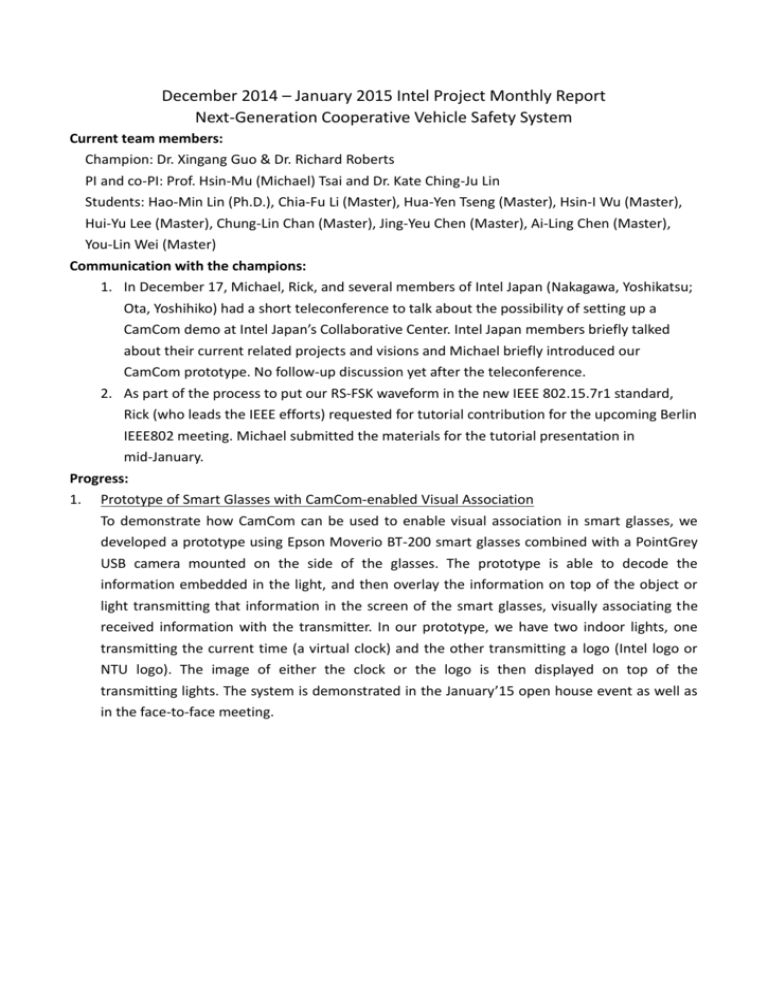December 2014 – January 2015 Intel Project Monthly Report Next
advertisement

December 2014 – January 2015 Intel Project Monthly Report Next-Generation Cooperative Vehicle Safety System Current team members: Champion: Dr. Xingang Guo & Dr. Richard Roberts PI and co-PI: Prof. Hsin-Mu (Michael) Tsai and Dr. Kate Ching-Ju Lin Students: Hao-Min Lin (Ph.D.), Chia-Fu Li (Master), Hua-Yen Tseng (Master), Hsin-I Wu (Master), Hui-Yu Lee (Master), Chung-Lin Chan (Master), Jing-Yeu Chen (Master), Ai-Ling Chen (Master), You-Lin Wei (Master) Communication with the champions: 1. In December 17, Michael, Rick, and several members of Intel Japan (Nakagawa, Yoshikatsu; Ota, Yoshihiko) had a short teleconference to talk about the possibility of setting up a CamCom demo at Intel Japan’s Collaborative Center. Intel Japan members briefly talked about their current related projects and visions and Michael briefly introduced our CamCom prototype. No follow-up discussion yet after the teleconference. 2. As part of the process to put our RS-FSK waveform in the new IEEE 802.15.7r1 standard, Rick (who leads the IEEE efforts) requested for tutorial contribution for the upcoming Berlin IEEE802 meeting. Michael submitted the materials for the tutorial presentation in mid-January. Progress: 1. Prototype of Smart Glasses with CamCom-enabled Visual Association To demonstrate how CamCom can be used to enable visual association in smart glasses, we developed a prototype using Epson Moverio BT-200 smart glasses combined with a PointGrey USB camera mounted on the side of the glasses. The prototype is able to decode the information embedded in the light, and then overlay the information on top of the object or light transmitting that information in the screen of the smart glasses, visually associating the received information with the transmitter. In our prototype, we have two indoor lights, one transmitting the current time (a virtual clock) and the other transmitting a logo (Intel logo or NTU logo). The image of either the clock or the logo is then displayed on top of the transmitting lights. The system is demonstrated in the January’15 open house event as well as in the face-to-face meeting. 2. Expand the bandwidth of CamCom systems with multiple cameras: In the CamCom protocol we purposed last year, the range of frequency used in transmitting (i.e. the bandwidth) is constrained by the rolling shutter sampling rate of the CMOS camera and the size of the transmitting light in the image. If the transmitted frequency is higher than the rolling shutter sampling frequency, aliasing would be observed and the receiver would be unable to determine the transmitted frequency (because there are more than 1 possibilities). The figure below shows an example. The x-axis represents the actual transmitted frequency while the y-axis represents the observed frequency. This problem can be solved by using more than one camera, each with different rolling shutter sampling rate (i.e., different read-out time). The obtained signal will follow the Nyquist sampling theorem, i.e., if the transmitted frequency is higher than half of the sampling frequency, the observed frequency will be “folded” in a zig-zag manner and forms a cycle whose “period” is the sampling frequency, as shown in the figure below. As a result, we can use, for example, two cameras with different sampling rate to determine the original transmitted frequency, which can now be higher than the sampling rate of both cameras, shown below: With this approach, the usable range of frequency, i.e., bandwidth, can be greatly expanded for the CamCom system. We plan to explore this new idea in the next couple of months. Brief plan for next month: 1. Design MAC protocols for vehicular VLC (photodiode-based) to avoid problems such as hidden terminal / expose terminal. Experiments will be carried out with off-the-shelf automotive lights and our VLC receiver to determine appropriate decoding and interfering range. These values will then be used in simulations to determine the improvement of throughput using different flavors of MAC protocols. 2. More experiments will be carried out to evaluate the feasibility of the dual-camera CamCom systems.









